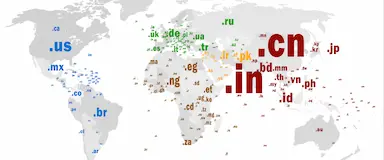With generic TLDs being oversaturated and marketed globally, country domains can help you reach a local audience and boost SEO.
How Do You Register a Domain Name
Written by Liam Campbell ·

If you're looking to establish your online presence, one of the first and most important steps is registering a domain name. This guide will walk you through everything you need to know about domain registration—from understanding what a domain name is to the step-by-step process of securing your own web address. Whether you're launching a personal blog, a small business website, or an online portfolio, this comprehensive guide will help you navigate the domain registration process with confidence.
Table of Contents
- What Is a Domain Name and Why It Matters
- Understanding Domain Types: ccTLDs vs. gTLDs
- Step-by-Step Domain Registration Guide
- Domain Pricing and Budget Considerations
- SEO and Trust Factors When Choosing Domains
- Using Domain Name Generators for Ideas
- Frequently Asked Questions
- Conclusion: Securing Your Online Identity
What Is a Domain Name and Why It Matters
A domain name is essentially your website's address on the internet. Instead of having to remember complex numerical IP addresses (like 192.168.1.1), domain names provide an easy-to-remember text-based label that directs visitors to your website. For example, google.com and register.domains are domain names that point to specific websites.
Think of your domain name as your digital street address. Just as your physical address helps people find your home or business in the real world, your domain name helps people find your website in the vast landscape of the internet.
Why Domain Names Are Essential
Benefits of Having Your Own Domain
- Professional Appearance: A custom domain instantly makes your website look more professional and trustworthy compared to using a free subdomain.
- Brand Building: Your domain becomes part of your brand identity, helping with recognition and recall.
- Professional Email: Create email addresses with your domain name ([email protected]) for a more professional image.
- Better Memorability: A well-chosen domain name is easier for visitors to remember and share with others.
- Control and Ownership: You maintain control over your online presence rather than relying on a third-party platform.
Drawbacks of Not Having a Domain
- Unprofessional Image: Using free hosting with their subdomains can make your site appear amateur or temporary.
- Limited Branding: Makes it harder to establish a unique brand identity online.
- Risk of Platform Changes: If using a website builder's free domain, you're subject to their terms, which may change.
- Harder to Share: Long, complicated subdomain addresses are difficult for people to remember and type correctly.
- Loss of Credibility: Many visitors instinctively trust websites with proper domains more than those without.
Understanding Domain Types: ccTLDs vs. gTLDs
The part that comes after the dot in a domain name (like .com or .us) is called a top-level domain (TLD). Understanding the different types of TLDs is important when choosing the right domain for your needs.
Generic Top-Level Domains (gTLDs)
These are the most common domain extensions that aren't tied to any specific country. Examples include:
- .com - The most popular and recognized TLD, ideal for commercial websites and businesses (over 161 million registrations as of mid-2023)
- .org - Originally intended for organizations and non-profits, but now used more broadly
- .net - Originally meant for network-related sites, now used generally
- .info - For informational websites
In recent years, hundreds of new gTLDs have been introduced, providing more specific and creative options:
- .store - Perfect for e-commerce sites
- .blog - Ideal for blogging platforms
- .tech - Great for technology companies and startups
- .app - Designed for mobile applications and software
Country Code Top-Level Domains (ccTLDs)
These are two-letter extensions that represent specific countries or territories:
- .us - United States (requires U.S. presence and doesn't allow WHOIS privacy)
- .uk - United Kingdom
- .ca - Canada
- .de - Germany
- .au - Australia
Pro Tip: If you're building a site for a global audience, a .com domain is generally the safest choice due to its universal recognition. If you're focusing on a specific country or region, using that country's ccTLD can help establish local relevance and trust.
Step-by-Step Domain Registration Guide
Registering a domain name is a straightforward process that anyone can complete in just a few minutes. Follow these steps to secure your ideal web address:
1 Decide on Your Domain Name
Brainstorm several options for your domain name. The best domains are:
- Short and memorable
- Easy to spell and pronounce
- Relevant to your website's purpose or brand
- Free of hyphens and numbers (when possible)
Have backup options ready in case your first choice is already taken.
2 Choose Your Domain Extension
Select the appropriate TLD for your website. For most websites, .com remains the gold standard due to its familiarity and widespread recognition. If .com isn't available or doesn't fit your needs, consider alternatives like .net, .org, or one of the newer TLDs that might better represent your website's purpose.
3 Check Domain Availability
Go to a domain registrar like Register.Domains and use their search tool to check if your chosen domain name is available. Simply type your desired name in the search bar, and the tool will tell you if it's free to register or already taken.
4 Select an Available Domain
If your first choice is available, great! If not, you can:
- Try a different extension (.net instead of .com)
- Add a relevant word (like "the" or "my")
- Use a slight variation of your original idea
- Consider one of the registrar's suggested alternatives
5 Add to Cart and Create an Account
Once you find an available domain you like, add it to your cart. You'll need to create an account with the registrar if you don't already have one. Provide your contact information, which is required for the domain's public registration record (though privacy options are available).
6 Choose WHOIS Privacy Protection
Decide whether to keep your contact information public or private. WHOIS privacy protection (available from most registrars including Register.Domains) shields your personal details from the public database, protecting you from spam and identity theft. It's generally recommended for personal and small business websites.
Note: Some TLDs like .us don't allow privacy protection due to their registration requirements.
7 Configure DNS Settings
If you already have web hosting, you can enter your host's DNS (Domain Name Server) addresses to connect your domain to your website. If you don't have hosting yet or aren't sure about these settings, you can use the registrar's default settings and change them later.
8 Select Registration Period
Choose how long you want to register your domain for, typically from 1 to 10 years. If you're just starting out, a 1-year registration is fine (you can always renew). Many registrars offer discounts for multi-year registrations. Consider enabling auto-renewal to prevent accidentally losing your domain when it expires.
9 Complete Your Purchase
Review your order, apply any available coupon codes, and complete your payment. Most registrars accept credit cards, PayPal, and various other payment methods.
10 Verify Your Email and Confirmation
After purchase, you'll receive a confirmation email. You may also get a separate email from ICANN (the organization that oversees domain names) asking you to verify your email address. Be sure to click the verification link to activate your domain fully.
Congratulations! Once these steps are complete, the domain is officially yours for the duration you paid for. As long as you continue to renew it before the expiration date, no one else can claim it.
Domain Pricing and Budget Considerations
Domain pricing varies depending on the extension and the registrar you choose. Here's what you should know about costs:
| Domain Type | Typical Price Range | Register.Domains Price | Notes |
|---|---|---|---|
| .com | $10-15/year | $6.99 (first year) | Most popular and recommended |
| .net, .org | $10-15/year | Competitive rates | Good alternatives to .com |
| New gTLDs (.app, .tech, etc.) | $15-50/year | Varies by TLD | More specific, but less familiar |
| Country codes (.us, .uk, etc.) | $8-20/year | Varies by country | Good for country-specific sites |
Cost-Saving Tips
- Compare first-year vs. renewal rates: Many registrars offer discounted first-year rates but charge more for renewals. Always check both prices.
- Look for bundled services: Some registrars include extras like email forwarding, privacy protection, or basic hosting at no additional cost.
- Multi-year registrations: Registering for multiple years upfront often reduces the per-year cost.
- Promotional codes: Search for coupon codes before completing your purchase.
Important: Be wary of extremely cheap domain offers. Some registrars advertise very low initial prices but may have hidden fees or significantly higher renewal rates. Always read the fine print!
SEO and Trust Factors When Choosing Domains
Your domain name can impact both how search engines view your site and how visitors perceive your credibility:
SEO Considerations
- TLD impact: Search engines don't generally favor one domain extension over another for ranking purposes. A .net or .org can rank just as well as a .com.
- Geographic targeting: Country-code TLDs (like .us or .uk) signal to search engines that your site is specifically relevant to that country, which can help with local SEO but may limit global reach.
- Domain age: Older domains sometimes have a slight advantage in SEO, but content quality and relevance are far more important factors.
- Keywords in domains: While including keywords in your domain was once highly beneficial for SEO, it's now much less important. Focus on brand-ability rather than keyword stuffing.
Trust and User Perception
- Familiar extensions: Users tend to trust .com domains most, followed by other well-established TLDs like .org and .net.
- Brand alignment: A domain that clearly reflects your brand name builds recognition and trustworthiness.
- Length and simplicity: Shorter, easier-to-spell domains appear more professional and are less prone to typing errors when users try to visit your site.
- Avoid confusing characters: Hyphens, numbers, and unusual spellings can make your domain harder to remember and may reduce perceived credibility.
Using Domain Name Generators for Ideas
Coming up with a good domain name can be challenging, especially when so many common names are already taken. Domain name generators can help spark creativity and find available options:
How Domain Name Generators Work
These tools take your keywords or business name and generate lists of available domain suggestions by:
- Adding prefixes or suffixes
- Combining related terms
- Suggesting synonyms or variations
- Checking availability across different TLDs
Register.Domains offers an advanced AI-powered domain name generator that can provide intelligent, contextual suggestions based on your input.
Tips for Using Domain Generators Effectively
- Enter multiple keyword combinations: Try different combinations of terms related to your business or website.
- Be open to different TLDs: If your perfect name isn't available as a .com, consider other extensions.
- Look for brandable names: Focus on names that could serve as a strong brand rather than just describing your products or services.
- Check pronunciation and spelling: Make sure the suggested names are easy to pronounce and spell when heard.
Frequently Asked Questions
Most domain registrations activate within minutes to a few hours after purchase and email verification. However, it can take up to 48 hours for the domain to fully propagate across all DNS servers worldwide.
Yes, you can transfer your domain to another registrar after it's been registered for at least 60 days (ICANN rule). The process typically involves unlocking the domain at your current registrar, obtaining a transfer authorization code, and initiating the transfer at the new registrar.
Domain registration gives you ownership of a web address (like yourname.com), while web hosting provides the server space where your website's files are stored. You need both to create a functioning website that others can visit online.
If your domain expires, it typically enters a grace period (usually 30 days) where you can renew it at the standard rate. After that, it enters a redemption period where renewal is possible but at a much higher fee. Eventually, the domain returns to the public pool where anyone can register it.
You cannot register a domain that's already registered by someone else. However, you may be able to purchase it from the current owner if they're willing to sell. Some domains are listed on marketplace websites, or you can attempt to contact the owner through their WHOIS information (if public) or through a domain broker service.
Conclusion: Securing Your Online Identity
Registering a domain name is one of the most important first steps in establishing your online presence. Your domain is more than just a web address—it's the foundation of your digital identity, a key component of your brand, and often the first point of contact between you and your audience.
By following the steps outlined in this guide, you can confidently secure a domain name that represents your brand well and serves your website's purpose. Remember to choose a trustworthy registrar that offers competitive pricing, reliable service, and helpful customer support.
Ready to Register Your Perfect Domain?
At Register.Domains, we make domain registration simple and affordable. Get started with a .com domain for just $6.99 for your first year, complete with our AI-powered domain name generator to help you find the perfect web address.
Search For Your Domain NowWith your domain name secured, you'll be ready to move on to the next steps of building your website, setting up professional email addresses, and establishing your unique place in the digital world.
References and Additional Resources
- ICANN (Internet Corporation for Assigned Names and Numbers). "About WHOIS." https://whois.icann.org/en/about-whois
- Internet Society. "History of Domain Names." https://www.internetsociety.org/
- W3C (World Wide Web Consortium). "Web Naming and Addressing Overview." https://www.w3.org/addressing/
- Mozilla Developer Network. "What is a Domain Name?" https://developer.mozilla.org/
- Search Engine Journal. "Does Domain Extension Affect SEO?" https://www.searchenginejournal.com/
- ICANN. "New gTLDs Program." https://newgtlds.icann.org/
- Internet Assigned Numbers Authority (IANA). "Root Zone Database." https://www.iana.org/domains/root/db
- Domain Name Industry Brief. "Q2 2023 Report." https://www.dnib.com/



